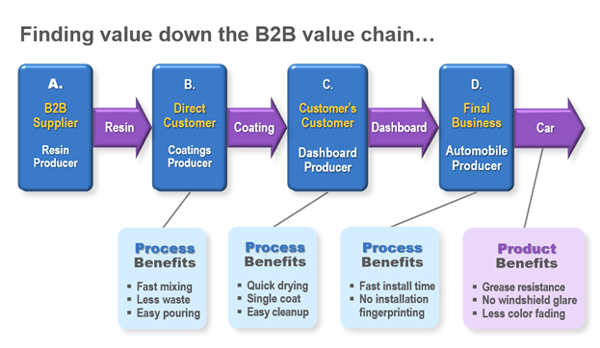Here's how you can help customers and customers' customers.
When you look down the B2B value chain in your target market, you may see opportunities to improve both products and services.
Imagine this scenario: B2B Supplier A sells paint resins to Coatings Producer B… which supplies plastic coatings to Dashboard Producer C… which supplies coated dashboards to Automobile Producer D. How can Supplier A add value to its downstream value chain?

B2B Supplier A has only two options. First, it can improve the process of any company along the value chain. It could improve the mixing time of resins at Coatings Producer B… or reduce the coating drying time at Dashboard Producer C… or accelerate dashboard installation time at Automobile Producer D.
Second, it can improve the final product at the end of the value chain… the finished car in this case. The resin might ultimately improve resistance to French fry grease, reduce windshield glare, or minimize color fading. But wait: Don’t the intermediate products (e.g. the coating from Coatings Producer B) count for something? Not really. These intermediate products matter only to the extent they impact a downstream process or the final product.
What about B2B Supplier A? Hasn’t it created value when it develops a cool new resin? It has not. It’s only established the potential for creating value. Value is not created until a downstream customer realizes an improvement in a process or the ultimate product. Some of this value is collected later by the supplier through higher prices or volume. This is more than semantics; it can and should change behavior in three ways.
- New starting point: Many suppliers start with their own idea of value, when they should begin by understanding which improvements customers
- Focus on improvement: Some suppliers think they are creating value when they are only matching They must improve upon the next best alternative.
- Learn how to collect value: Suppliers often guess at new product pricing. When a supplier understands how customers measure value, it stops leaving money on the table.
When you interview down the entire value chain, you can reap many benefits:
- You'll learn how to promote your new product to different points in the value chain
- You'll determine which point in the value chain deserves most of your innovation effort
- You can become a valued supplier to your direct customers by informing them of their customers' needs.
Are the needs of some downstream customers more important than others? Yes indeed. One point in the value chain is usually the driver for the rest of the chain. Your bicycle has a drive sprocket (with peddles attached) and a wheel sprocket. You need to identify the drive sprocket in your value chain and “peddle hard” at creating value there. Then the chain will spin the wheels for you.
You'll see some helpful advice for your value chain work in the next BlueHelp article, Practical tips for exploring your value chain.
Keywords: B2B customers, customers' customers, value chain driver, product improvement, process improvement, product vs. process, B2B products and processes, value chain, save or make money
